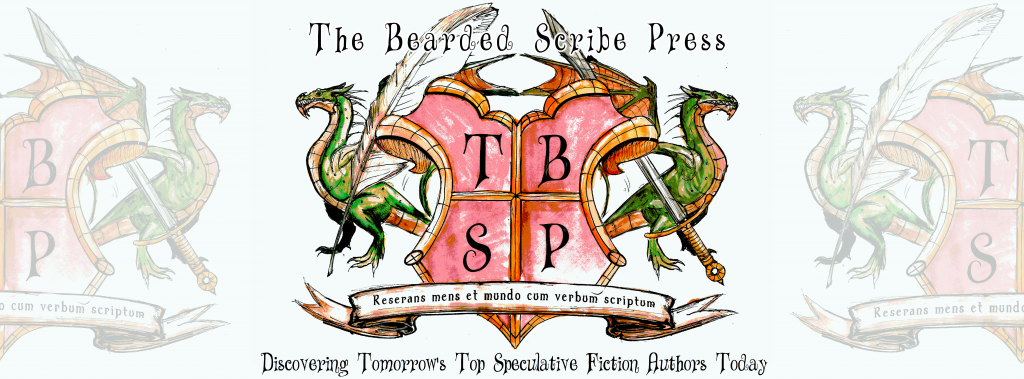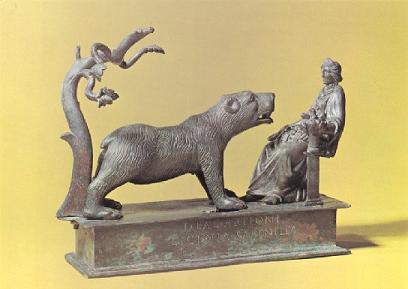Hang around The Bearded Scribe long enough, and you will inevitably catch a glimpse of Scottish pride amidst its contributors. Elizabeth is a direct descendant of Clan Ross, the first named clan, designated by King Malcolm IV of Scotland in the twelfth century; Sara is also of Scottish descent, and Joshua has a bit of all the British Isles in him from his mother's side.
If genealogical reasons of pride weren't enough, Joshua, Sara, and Elizabeth met when they were all students at Alma College, home of the Scots. (The city of Alma is nicknamed Scotland USA.) The College has its own registered tartan, which both the marching band and the pipe and drum corps wear for every performance; every convocation starts with the bagpipes; the Choir can often be heard in the Chapel (or, on occasion, in secluded churches in Scotland!) singing tunes such as "Loch Lomond" and "Highland Mary;" and at the end of Spring Term, the students must vacate the dorms to make way for the Highland Festival, a huge gathering including traditional Highland music and dance, a nearly-frightening number of men in kilts, and Highland games.
It is because of this Scottish pride that The Bearded Scribe excitedly brings you its second ever Movie Spotlight on Disney/Pixar's latest film, Brave. And to top it all off, it is the first ever post to appear on the blog with two contributors! (We're sure it won't be the last!)
Plot Summary A born tomboy and expert archer, Merida is not your average girl, but, as her mother often reminds her, she’s a princess, and with that comes expectations. The clans are about to gather, bringing their suitors to compete for Merida’s hand, and of course, Merida wants nothing to do with it—especially after she sees just who these potential suitors are. She devises a way to compete herself so as not to have to get married, but it causes her worst fight yet with her mother and Merida runs away. Deep in the woods, she follows will-o’-the-wisps to a witch’s cottage. The witch gives her a spell to change her fate, but when the spell backfires, trapping her mother in the form of a bear, Merida must use all her wits and skills—princess-like and otherwise—to save both her independence and her family.
The Land One of the greatest aspects of Brave is the film's unforgettable landscape, beautifully portrayed through superb animation. The entire "world" built by the film is complete, and the landscape alone is merely one of its facets. In addition to the lush, green rolling hills, the crags and high cliffs, and the architecture of monuments and buildings, the film includes key elements to the traditional, Celtic culture. Intricate knotwork is carved on wood and stone throughout—including Merida's bow. Nary a scene exists without a man in a kilt or some display of tartan (ever wonder what the Scotsmen wear under those kilts... watch this film and you will no longer), a few of its characters adorned in woad paint (a tip of the hat to Braveheart, perhaps?), and fanciful tapestries line many a wall. Many of the Scottish traditions outlined in our intro are beautifully and respectfully reflected in Brave, one of them specifically is that of the Highland Games. According to tradition, each clan presents its most desirable suitor for the hand of the Princess, and the winner is determined through a test of her choosing. Brave’s focus is not mainly on romance; rather, in a stroke of unconventional plotting, the games serve as an impetus for the main conflict between Merida and her mother, and between Merida and the conventions of her society. Another aspect we loved about Brave is the wonderful music contained in its soundtrack. As we are both vocalists and lovers of music, this was one aspect, in our humble opinion, the film had no room to get wrong. They didn't. The composer of the film's musical score, Patrick Doyle—also the composer of Harry Potter and the Goblet of Fire—used traditional Scottish instruments such as the bagpipes, a solo fiddle, Celtic harps, and the bodhrán, just to name a few. Doyle was quoted as saying, "I employed many classic Scottish dance rhythms such as reels, jigs, and strathspeys, which not only serve the action but keep it authentic." The only issues we found with the world-building of the film were anachronisms. Given the film was fictionally set in 10th Century Scotland, the use of plaid (15th-16th Century), kilts (18th century); forks (16th century); Shire horse (breed developed in the mid-17th century) and fighting the Romans (1st-5th century) all fit the bill. Because we love all things Scottish, we happily forgive them.
The Legend
If there is something that must be mentioned, it is the way elements of folklore and mythology are interwoven throughout the entire film. While there is no precedence for the actual legend of the plot, other elements from Celtic lore are used ingeniously to drive home the “fairytale” aspect. From its very start, we are introduced to will-o'-the-wisps—colloquially referred to as "wisps"—which Merida is told (by her mother) are said to lead a person to their fate. The “wisps” vanish when approached, just as the actual lore states; ironically, however, in most Celtic lore a “wisp” (or ignis fatuus) is said to lead travelers away from the safety of the path (into bogs and other treacherous destinations). Continuing with the “fairytale” notes is the sacred henge in which the final showdown takes place. It represents not only the sacred rock formations that speckle the British Isles, such as Stonehenge—which are placed on sacred sites filled with the natural energies from the Earth—but also the smaller-scale formations referred to as “faerie rings.” These sites were said to be portals to the land of the Sidhe, and were to never be entered. Merida's horse, Angus, obeys this superstition by stopping suddenly at its edge, meanwhile throwing Merida into its center. The fact that the wisps appear from this site to lead Merida to witch's cottage is another allusion to the Faefolk they are meant to represent.
Another mythological element which is prevalent—if not pervasive—is that of the bear. While researching for this post, we discovered a possible connection between Queen Elinor and the Celtic Bear Goddess, Artio, often referred to as “Mother Bear.” We even uncovered an ancient statue of said goddess that appears strikingly similar to one that may or may not have made an appearance in the witch's wood-carving shop. The legends and myths that appear throughout the film and its landscape are like the tapestry in the film; they are tightly woven, never to be torn from one another. The mistakes and stories of the past—however far-fetched and magical they might seem—are there to educate generations of the future. We must take heed and not dismiss them so quickly, which echoes Queen Elinor's line in the movie:
“Legends are lessons, and they ring with truths!"
The Lessons Learned As firm believers that no woman should need a man to make her complete, we really enjoyed seeing a Disney/Pixar film wherein romance is present without being the main focus of the plot. We’re not anti-love by any means, and both agreed that the romance between the Queen Elinor and King Fergus is sweet. Love, after all, makes life sweeter, but love comes in more forms than just romance. Merida is a tenth-century girl with a twenty-first century mindset, and her independence and determination is refreshing. She knows she can do better than any of the suitors she is offered, and she’s not willing to compromise or settle—a position we totally support.
Unless you've been living under a menhir somewhere—or trapped under one—you've most likely heard the expression: “Be careful what you wish for.” The main theme of Brave is exactly this, and it is an expression Princess Merida already knows all too well. Despite this, she wishes for her mom to change, and when the Queen is transformed into a bear, Merida must deal with the consequences. Afraid for her mother's life—due to her father's understandable hatred of bears—Merida and the Queen flee the family's castle in search of the witch or the wisps that led her to her fate. While helping Merida with trying to find a way to reverse the spell, Queen Elinor gains respect for her daughter's strength and wilder side; Merida, too, finds a deeper respect for her mother when faced with the prospect of losing her forever. Also, they discover that Merida is not the first to wish for a change of fate, and by repairing the mistakes she made, she has the opportunity to correct the wrongdoings of the past.
In Conclusion Given our love affair with all things Scottish, we had high hopes for Brave, and we weren’t disappointed. Add in a strong female lead, stirring soundtrack, and beautiful scenery and animation, and our separate trips to see this film were time well spent. As a bonus, it gave us a chance to truly collaborate for the first time, a practice we hope to keep up in the future!
Rating:





Thank you, Elizabeth, for all your help with The Bearded Scribe. Thank you for sharing such a passion for books, writing, and speculative fiction. Thank you for the opportunity to co-author this post with you, and I look forward to co-authoring more!
ReplyDelete